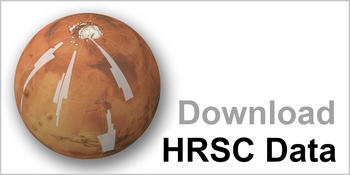Department of Earth Sciences
Service Navigation
Flight around Noctis Labyrinthus – Special PR #2 2023
This film was created using an image mosaic made from eight single orbit observations of the High Resolution Stereo Camera (HRSC) on board ESA’s Mars Express mission. The film shows a flight over the eastern part of Noctis Labyrinthus.
Credit: ESA/DLR/FU Berlin & NASA/JPL-Caltech/MSSS (CC BY-SA 3.0 IGO)
Orbits: 0442, 1085, 1944, 1977, 1988, 10497, 14632, 16684
Coordinates: 7°S & 265°E
|
Animation "Flight around Noctis Labyrinthus" [798 MB] |
This mosaic image is combined with topography information from a digital terrain model (DTM) to generate a three-dimensional landscape. Every second of the movie consists of 50 separate frames that are rendered following a pre-defined camera path in the scene. The opening credits (Mars globe) were created using the Mars global color mosaic (20th anniversary special) with a 3-fold vertical exaggeration. The vertical exaggeration used for the animation “Flight around Noctis Labyrinthus” is 1.5-fold. The haze has been added to conceal the limits of the terrain model. It starts building up at 150-200 km distance.
Labyrinth created by extensional tectonism
The Noctis Labyrinthus region (Latin for “labyrinth of night”) is located between the western edge of Valles Marineris, the “Grand Canyon of Mars” and the Tharsis upland. It shows a length of 1190 km and is characterized by a labyrinth-like system of deep, steep-walled valleys formed by faulting. Many of the valleys show the classical appearance of so-called graben. A graben is a part of the crust that has subsided in relation to the blocks on either side. The faults typically dip toward the center of the graben from both sides. The fractures are witnesses of extensional tectonics. The intense volcanism in the Tharsis region was associated with an up-arching of large areas.
This process resulted in tectonic stress, causing the crust to thin out and lead to the graben formation. Large plateaus representing the original surface level dominate the region. The intersecting canyons and valleys are up to 30 kilometers wide and up to six kilometers deep. In many places, gigantic landslides can be found, covering the steep valley slopes and the valley floors. In other places, large linear structures can be found on the valley slopes. These structures are wind-blown sand deposits, accumulating to large dune fields. The alignment of the dune crests indicates that in some areas the sand was transported downslope, while in other places, the dune sand has been blown uphill.
High Resolution Stereo Camera
The High Resolution Stereo Camera was developed at the German Aerospace Center (DLR) and built in collaboration with partners in industry (EADS Astrium, Lewicki Microelectronic GmbH and Jena-Optronik GmbH). The science team, which is headed by Principal Investigator (PI) Dr. Thomas Roatsch, consists of 52 co-investigators from 34 institutions and 11 countries. The camera is operated by the DLR Institute of Planetary Research in Berlin-Adlershof.
Images: ESA/DLR/FU Berlin & NASA/JPL-Caltech/MSSS (CC BY-SA 3.0 IGO)
Copyright Notice:
Where expressly stated, images are licensed under the Creative Commons Attribution-ShareAlike 3.0 IGO (CC BY-SA 3.0 IGO) licence. The user is allowed to reproduce, distribute, adapt, translate and publicly perform it, without explicit permission, provided that the content is accompanied by an acknowledgement that the source is credited as 'ESA/DLR/FU Berlin', a direct link to the license text is provided and that it is clearly indicated if changes were made to the original content. Adaptation / translation / derivatives must be distributed under the same license terms as this publication.


